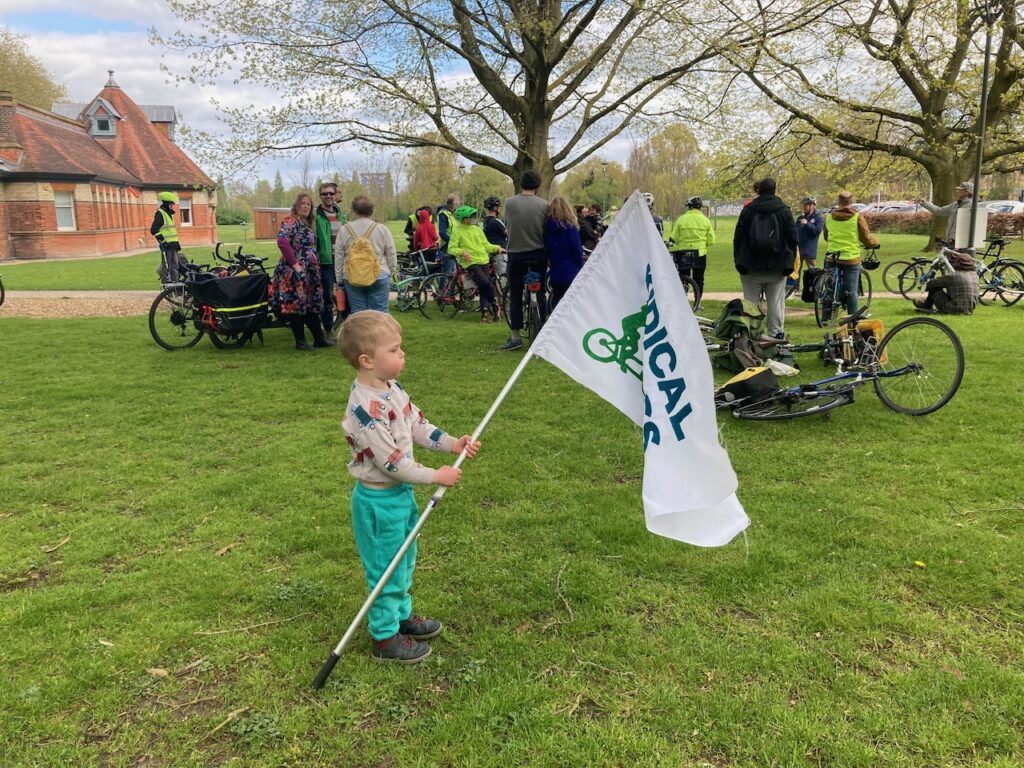Last weekend’s ride was a 4km loop from the Lido which went through the town centre. Some of our riders were very small, but still very nippy, and we had great fun riding together. After the ride we enjoyed swapping advice on different cycling setups with other families. We had a good turnout from the Reading Cycle Campaign – a group with which we share the common goal of pushing for improved cycling infrastructure in Reading.
Joe Edwards, the chair of RCC, mentioned that he had seen my recent article about Kidical Mass which was published in “Cycle” (from Cycling UK). Cycling UK also shared the article on their Facebook page. The vast majority of responses were enthusiastic and kind, but there were (naturally) a few idiots complaining about kids being “used to make a political point.”

This bamboozled me. The framework in which we all live our lives – what rights and responsibilities we are given, what options there are available to us, what safety we have – is dictated by the politics of our countries. Kids cannot escape the effects of politics. They generally spend a large proportion of their time in government run institutions. They are relatively small and powerless – a teenager who cannot travel safely by bike does not have the option to drive themselves independently. They are the ones who will have to live the longest with the consequences of the action we do or don’t take on climate change. To insist that it is somehow not fair play to make these points is to say quite clearly that you don’t care about them.
So, yes, the families here at Kidical Mass Reading do believe in engaging with our political systems to ask for better for our children. We were therefore delighted to have representation at April’s ride from three different political parties. Labour Cllr John Ennis, who is the lead councillor for climate strategy and transport gave a candid speech at the rally after the ride, in which he asserted that the council is determined to make cycling in Reading easy and safe, and acknowledged that at the moment it often falls short of that goal. He placed the blame largely on the lack of funding available for active infrastructure, and certainly this is part of the story. We were able to offer our thanks that he and his colleagues were able to reinstate (and in some cases improve) the cycling infrastructure on Lower Henley Rd that the council removed earlier this year. Mr 7 used it to ride his own bike to school on Friday, and we are very glad about its return.

Henry Wright, the Liberal Democrat parliamentary candidate for Reading, also joined us for the ride. Speaking to him afterwards he said that he regularly commutes by bike to work, and he sees that the cycling infrastructure we have is not good enough. He too wants to see a bigger investment in making our streets safe.
Cllr Dave McElroy of the Greens and Cllr James Moore of the Liberal Democrats also joined us, and were brave enough to ride together on our tandem (after an initial test run twenty minutes before the ride). As they were slightly wobbly they stayed near the back of the ride, and as back marker I was able to take the opportunity to point out the wonderful placement of my favourite bollard near Forbury Gardens (more of that sort of thing, please).

Having the two of them on the tandem was a great metaphor for the kind of cross party collaboration that we need to see at all levels of government if we want to see investment, action and change on cycling infrastructure. If you too think this is important then don’t forget to vote in the local and Police and Crime Commissioner elections on the 2nd May – and please do join us for our next ride on Saturday 18th May.



























